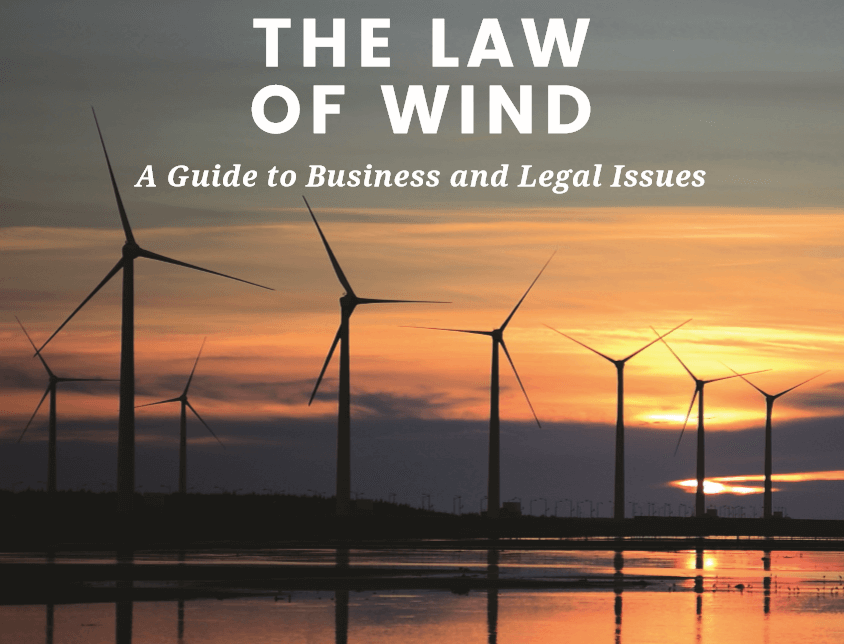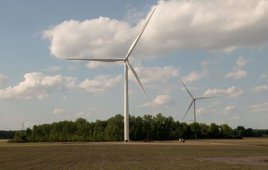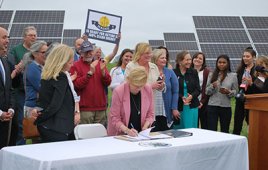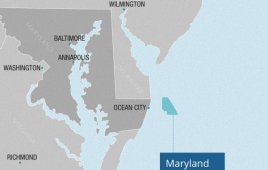This article comes from the Forward of the report: http://files.stoel.com/files/books/LawofWind.PDF
Two decades ago, utility-scale wind-powered electric generation was still an untried novelty in the United States. In those days, some utilities purchased wind power as a result of requirements imposed by their state regulators. Others did so in order to garner some favorable PR as the public grew more concerned about the contribution of fossil fuel generation to climate change.

Notwithstanding the intermittent nature of wind, utilities have come to appreciate its ability to produce significant power at a price that was fixed for the life of the offtake agreement. This trend has continued to the present.
But as developers got better at siting, building, and operating wind projects; equipment manufacturers improved the productivity of their machines; and utilities suffered the economic hits that resulted from what was then a volatile natural gas market with prices sometimes spiking by several hundred percent in a short period of time, the value of wind as part of the resource mix in an integrated generation portfolio slowly began to be realized.
Notwithstanding the intermittent nature of wind, utilities came to appreciate its ability to produce significant megawatts at a price that was fixed for the life of the offtake agreement. This trend has continued to the present.
The industry has shown itself capable of continuing to improve wind project output, lowering the price to where, for several years now, it is price competitive with natural gas—and this in a fracking environment where the price of natural gas has been at all-time lows and its pricing volatility has yet to re-emerge.
And despite an unfavorable political climate that seeks to promote a resurgence of coal-fired generation, the electric industry continues to retire coal plants, speaking loudly as to its vision of the future notwithstanding the short-sightedness of the current group of politicians in Washington.
The loss of the production tax credit in the next few years will no doubt require some adjustment and reposturing. But when one considers that the price of wind has been reduced from over $90 per MWh in the early 2000s to well under $25 per MWh in recent years, there is every reason to have confidence that the industry will meet this challenge as well.
As one of the first law firms to focus on wind energy, Stoel Rives is pleased to have worked with so many talented industry players over the years to help bring wind generation to its current level of success. Our dedication to assisting the industry in moving forward is demonstrated by the significant time and effort we have devoted to preparing and keeping current materials like The Law of Wind and its companion publications in other areas of renewable energy.
As attorneys, we take seriously our duty to help educate the industry and the public in general on the legal aspects of developing, constructing, financing, and operating wind energy resources. This represents the eighth edition of The Law of Wind. As the industry has matured, much of the legal environment has become well known, perhaps even routine in many instances. And yet there are still significant developments that require tracking. For example, the impact of the 2017 tax reform act, the integration of storage solutions, and the continued buildout of the transmission system to bring wind power from windy sites to load centers all continue to present new challenges for the industry to meet and the law to accommodate.
With this edition, we once again renew our dedication to the wind industry and our commitment to provide informed, experienced advice to all who share our dream of a cleaner energy future. We hope you find The Law of Wind useful. Please note that PDF versions of this document are available for download at no charge via our website, www.stoel.com/lawofseries.
Let us know how well it serves your needs—suggestions or comments on how it could be improved are most welcomed. Also, you can follow our summaries of and comments on important developments in the industry through our Energy Law Alerts (www.stoel.com/subscribe) and in our Renewable + Law Blog (www.lawofrenewableenergy.com). Edw. D. Einowski, Partner Partner stoel.com/eeinowski 503-294-9235 (Portland)
Chapter One
Wind Energy Lease Agreements
Eugene A. Frassetto, Ramona L. Monroe, Sarah Johnson Phillips
At the core of a wind energy project’s overall value is the security, flexibility, cost-effectiveness, and stability of the land rights for the project. The tool for capturing this value typically is a wind energy lease or easement agreement that creates and protects a developer’s interest and investment in the property and project, and provides reliable income to the landowner, while offering the developer the flexibility to transfer all or portions of the project over its lifetime.
Form of Agreement/Use of Option
A real property ground lease or easement rights for developing a wind project site with its accompanying wind resource easement and noninterference covenants (generally, together, a “Wind Energy Land Agreement”) is similar, in many ways, to an agreement for a ground lease or other agreement for the temporary use of land for commercial or industrial development.
A Wind Energy Land Agreement provides for the developer’s entry onto and investigation of the property, and sets forth the term; the scope of the permitted uses of the property by the developer and the landowner; the amounts and methods of payment for the leasehold and/or easement interests; the allocation of insurance and other costs between the parties; the transferability and financing of the development; notice, default, and cure provisions; and other matters that may be required by applicable law, the specific needs of the parties, or the particular circumstances.
However, Wind Energy Land Agreements are unlike a common, commercial ground lease arrangement in their treatment of the scope and use of the property, and, when well crafted, should anticipate changes in the ownership of the project and the property, and changing uses of the project property. This chapter outlines some common concepts, provisions, and potential issues in a typical site control arrangement.
For the full report: http://files.stoel.com/files/books/LawofWind.PDF
Filed Under: Uncategorized




